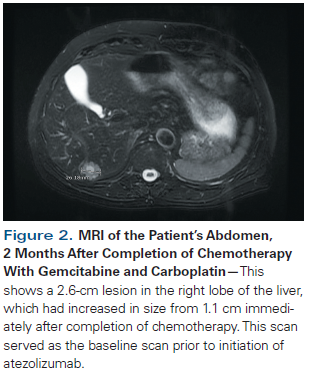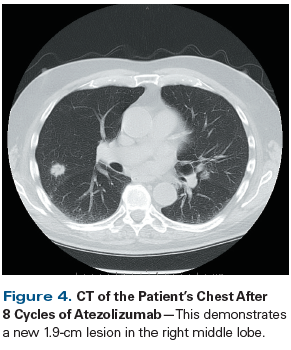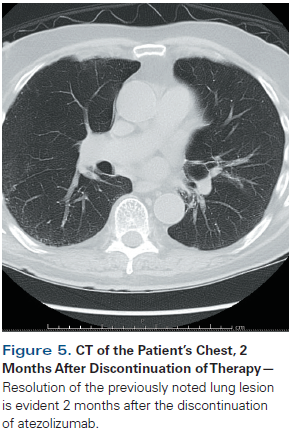The Case
An 83-year-old man-an ex-smoker with a history of hypertension, coronary artery disease, and multiple abdominal surgeries associated with a bowel perforation-was diagnosed with multiple low-grade transitional cell carcinomas over a 6-year period, with the first of these diagnosed when he was 73 years old. He underwent four transurethral resection of bladder tumor procedures during that time and received one treatment with intravesical mitomycin. A surveillance cystoscopy in year 7 showed high-grade noninvasive papillary urothelial carcinoma in the bladder trigone. A CT urogram showed a soft-tissue mass with diffuse enhancement in the lower pole of the left kidney, concerning for malignancy.
The patient underwent a ureteroscopy and stenting of the left ureter with resection of the mass, which was consistent with high-grade papillary urothelial carcinoma. He then received 6 treatments with intravesical bacillus Calmette–Guérin therapy. It is unclear why a nephroureterectomy was not performed at this time, given that this would have been standard of care.
Unfortunately, follow-up ureteroscopy performed 3 months later revealed a mass in the left renal pelvis. He underwent a left nephroureterectomy; final pathology was consistent with a high-grade urothelial carcinoma extending into the renal parenchyma, pathologic stage pT3NX. He did not receive adjuvant chemotherapy because he was not a candidate for cisplatin, due to an elevated creatinine level and his underlying cardiac disease. Surveillance cystoscopies were negative for the next year; however, in year 8, he was found to have a recurrence in the left renal pelvis, as well as new liver lesions. MRI of the abdomen showed multiple masses in the liver, with the largest measuring 4.9 cm × 4.4 cm (Figure 1). A positron emission tomography scan confirmed at least seven fluorodeoxyglucose-avid liver lesions. Biopsy of the liver demonstrated poorly differentiated carcinoma diffusely positive for GATA3 and CK7, with focal positivity for CK20, consistent with urothelial carcinoma.
As before, because of his elevated creatinine level and underlying cardiac disease, the patient was not a candidate for cisplatin. He received 6 cycles of gemcitabine and carboplatin. (While carboplatin has not been shown to improve overall survival in the adjuvant setting, it can be used in the metastatic setting for patients who are ineligible to receive cisplatin.) After he completed the 6 cycles, all liver lesions were nearly resolved, with the three remaining lesions measuring 0.6 cm, 0.8 cm, and 1.1 cm. However, a follow-up scan 2 months after completion of treatment showed growth of the hepatic lesions, with the largest measuring 2.6 cm (increased from 1.1 cm on the prior scan) (Figure 2).
The patient was then started on second-line atezolizumab. MRI of the abdomen after 4 cycles of atezolizumab showed a mixed response, with two of the liver lesions having shrunk (down to 1.4 cm from 2.0 cm, and to 1.3 cm from 2.6 cm) and one lesion having increased from 2.4 cm to 3.6 cm. Repeat MRI after 8 cycles showed further decreases in the size of the liver lesions-down to 1.2 cm, 0.6 cm, and 2.0 cm, respectively (Figure 3). Unfortunately, a chest CT scan performed at the same time showed multiple new bilateral lung nodules (a 1.3-cm nodule in the right upper lobe, a 1.9-cm nodule in the right middle lobe [Figure 4], a 1.0-cm nodule in the left upper lobe, and a 1.3-cm nodule in the left lower lobe).
Which of the following represents the next best step in management for this patient?
A. Cytotoxic chemotherapy
B. Stereotactic body radiotherapy for the lung lesions
C. Continuation of atezolizumab
Correct Answer: C
Discussion
This case involves a patient with metastatic urothelial carcinoma receiving second-line therapy with atezolizumab, in whom imaging demonstrated progressive disease after he had completed 8 cycles of therapy. Urothelial carcinoma, also known as transitional cell carcinoma, is the sixth most common form of cancer in the United States.[1] In 2017, there were approximately 80,000 new cases of bladder cancer and 17,000 deaths due to this disease.[1]
Until recently, treatment for metastatic urothelial carcinoma was platinum-based chemotherapy, and the 5-year survival rate was dismal-only about 5%.[2] However, there is no cytotoxic chemotherapy that has been approved by the US Food and Drug Administration (FDA) for second-line treatment of urothelial carcinoma. Studies with second-line agents such as single-agent taxanes have shown low response rates, considerable toxicities, and no survival benefit.[3] Thus, Answer A is incorrect.
Immune checkpoint inhibitors were developed for second-line treatment of metastatic urothelial carcinomas since these tumors have the third highest mutation rate[4] of all studied cancers, and because in both lung cancer and melanoma, high mutational burden has correlated with better responses to immune checkpoint blockade.[5,6] As part of the immune checkpoint system, programmed death 1 (PD-1) and programmed death ligand 1 (PD-L1) play important roles in allowing tumor cells to evade the immune system, and both are highly expressed in many tumor types, including urothelial carcinoma. The binding of PD-1 to PD-L1 inhibits T-cell proliferation, production of cytokines, and cytotoxic activity-which leads to T-cell exhaustion. Antibodies against PD-1 and PD-L1 allow the T cells to remain active and able to recognize the tumor as foreign, with a resultant demonstration of antitumor activity. Atezolizumab (a monoclonal antibody to PD-L1) and nivolumab (a monoclonal antibody to PD-1) are both FDA-approved for second-line therapy in metastatic urothelial carcinoma, and a number of other agents are under investigation.
Because these agents work by activating the immune system, they can occasionally lead to edema and an influx of immune cells into the tumor, which can appear as tumor progression on imaging, based on the conventional criteria that are used to assess tumor response (Response Evaluation Criteria in Solid Tumors [RECIST]). Patients with melanoma treated with ipilimumab (a monoclonal antibody to cytotoxic T-lymphocyte–associated antigen 4), another immune checkpoint inhibitor, had an initial increase in tumor size prior to a decrease in tumor burden. Biopsy of these enlarging lesions showed inflammatory cells or necrosis.[7] Similarly, tumor shrinkage in some patients is delayed until after the appearance of new lesions. These experiences led to the identification of the phenomenon of “pseudoprogression” that is seen in some patients treated with immune checkpoint inhibitors-and to the development of immune-related response criteria (irRC).
Immune-related responses have been reported in some studies of immune checkpoint inhibitors. These trials have reported the presence of additional patients with distinct immune-related patterns of response that did not meet RECIST criteria-44 of 1,126 patients, or about 4%; however, this is likely an underestimate, given that irRC were not used in all trials.[8] In the phase I trial of atezolizumab in metastatic urothelial carcinoma, 1 additional patient was identified as a responder based on irRC (1 of 65 patients, about 1.5%). In many of the trials leading to the approval of the immune checkpoint inhibitors, treatment of patients beyond conventional RECIST was permitted, provided that certain criteria were met, including maintenance of an acceptable performance status, consent of the patient, no impending end-organ damage, and no ongoing or serious toxic effects.[9] In the second cohort of IMvigor 210, a multicenter phase II trial of atezolizumab in the first line, 134 of the 310 patients were continued on treatment beyond progression as defined by RECIST. Of these 134 patients, 26 (19%) had a reduction in tumor burden, with ≥ 30% demonstrating a decrease in target lesions and 11 of 134 (8%) achieving a partial response, a complete response, or stable disease per RECIST, following progressive disease.[10] The median time to onset of first response was 2.1 months in this study, with two responses seen after 6 months of treatment.
Therefore, given that our patient was clinically well and had demonstrated a mixed response, as reflected on the scans and in the data reviewed previously, we elected to continue treatment with atezolizumab and confirm progressive disease after 2 cycles (Answer C), instead of switching to second-line chemotherapy.
KEY POINTS
- Platinum-based chemotherapy is used for metastatic urothelial carcinoma in the first-line setting.
- Immune checkpoint inhibitors (anti–PD-1 and anti–PD-L1 antibodies) are approved for use in the second-line setting for patients with metastatic urothelial carcinoma.
- There is evidence of delayed response to immune checkpoint inhibitors, and one can consider continuing these agents beyond a first scan showing evidence of progressive disease in a select group of patients.
Of note, clinical trials have also shown that the efficacy of checkpoint inhibitor therapy can be related to the development of immune-related adverse events (irAEs). A pooled analysis of three phase II studies in 343 melanoma patients treated with ipilimumab showed that for patients with no or only mild irAEs (grade 1), a disease control rate (stable disease plus partial response plus complete response) of 20% to 24% was achieved. In contrast, a disease control rate of 34% to 43% was achieved in patients with at least grade 2 irAEs.[11] Similarly, in melanoma patients treated with nivolumab, the objective response rate (ORR) was significantly better in patients who experienced irAEs of any grade compared with those who did not (48.6% vs 17.8%), with greater benefit seen in patients who reported three or more irAEs (ORR, 84.6%). However, there was no difference in ORR between patients in whom grade 3/4 irAEs occurred and those in whom irAEs were grade 2 or lower (31.5% vs 27.8%). The effect of immunomodulatory agents such as corticosteroids on ORR was also studied, and in this group of patients, there was no significant difference in ORR between patients who did and those who did not receive systemic immunomodulatory agents (29.8% vs 31.8%).[12]
Occasionally, in patients who develop a single new lesion and who have otherwise stable or shrinking disease, stereotactic body radiotherapy targeting that single lesion can be considered (Answer B). However, such an approach was not suitable for this patient, who had multiple new lesions.
Outcome of This Case
Because the patient was clinically well and a mixed response was seen on imaging, treatment with atezolizumab was continued, with a plan to reimage after 2 cycles, given the suspicion of pseudoprogression, which has been reported in trials of atezolizumab, as discussed. After he had completed a total of 10 cycles of atezolizumab, he was found to have an increase in both aspartate aminotransferase and alanine aminotransferase levels to > 2 times the upper limit of normal. Treatment was held at that time. A week later, he developed new generalized myalgia and polyarthralgia. Because of concern that these symptoms and findings represented autoimmune arthritis and hepatitis secondary to immune checkpoint inhibitor therapy, he was started on oral prednisone, 60 mg/d. Although his transaminase levels returned to normal soon after he started steroid treatment, he remained on low doses of prednisone for persistent arthritis.
Two months after he had started corticosteroid treatment, a chest CT scan demonstrated diffuse ground-glass opacities in both lungs; these lesions were seen predominantly in the right middle and lower lobes, along with subpleural reticulation and traction bronchiolectasis, which together were concerning for pneumonitis. The pneumonitis was also thought to be immune-mediated, and the patient’s prednisone dose was increased. He was kept on a very slow steroid taper. CT of the chest and MRI of the abdomen and pelvis obtained 2 months after discontinuation of atezolizumab showed complete resolution of all liver and lung lesions (Figure 5). Follow-up scans obtained 4 and 7 months after discontinuation of atezolizumab showed that he remains in complete response, without evidence of disease recurrence and off all antineoplastic therapy. This man’s disease course represents that of a patient who achieved a delayed, yet complete, response to atezolizumab (after 6 months of therapy) by being treated beyond progression based on standard response criteria. Of note, his response also coincided with the development of immune-mediated toxicities.
Financial Disclosure: Dr. Petrylak has served as a paid consultant to AstraZeneca, Bayer, Bellicum, Dendreon, Eli Lilly, Exelixis, Ferring, Johnson & Johnson, Medivation, Millennium, Pfizer, Roche Laboratories, and Sanofi Aventis; he has received grant support from Agensys, AstraZeneca, Bayer, Clovis, Dendreon, Eli Lilly, Endocyte, Genentech, Innocrin, Johnson & Johnson, MedImmune, Medivation, Merck, Millennium, Novartis, Pfizer, Progenics, Roche Laboratories, Sanofi Aventis, and Sotio; and he has partial ownership in Bellicum and Tyme. Dr. Mehra has no significant financial interest in or other relationship with the manufacturer of any product or provider of any service mentioned in this article.
E. David Crawford, MD, serves as Series Editor for Clinical Quandaries. Dr. Crawford is Professor of Surgery, Urology, and Radiation Oncology, and Head of the Section of Urologic Oncology at the University of Colorado School of Medicine; Chairman of the Prostate Conditions Education Council; and a member of ONCOLOGY's Editorial Board.
If you have a case that you feel has particular educational value, illustrating important points in diagnosis or treatment, you may send the concept to Dr. Crawford at david.crawford@ucdenver.edu for consideration for a future installment of Clinical Quandaries.
References:
1. Siegel RL, Miller KD, Jemal A. Cancer statistics. 2017. CA Cancer J Clin. 2017;67:7-30.
2. National Cancer Institute. Surveillance, Epidemiology, and End Results Program. SEER cancer stat facts: bladder cancer. http://seer.cancer.gov/statfacts/html/urinb.html. Accessed August 6, 2017.
3. Ning YM, Suzman D, Maher VE, et al. FDA approval summary: atezolizumab for the treatment of patients with progressive advanced urothelial carcinoma after platinum-containing chemotherapy. Oncologist. 2017;22:743-9.
4. Rosenberg JE, Hoffman-Censits J, Powles T, et al. Atezolizumab in patients with locally advanced and metastatic urothelial carcinoma who have progressed following treatment with platinum-based chemotherapy: a single arm, multicenter, phase 2 trial. Lancet. 2016;387:1909-20.
5. Rizvi NA, Hellmann MD, Snyder A, et al. Mutational landscape determines sensitivity to PD-1 blockade in non-small cell lung cancer. Science. 2015;348:124-8.
6. Snyder A, Makarov V, Merghoub T, et al. Genetic basis for clinical response to CTLA-4 blockade in melanoma. N Engl J Med. 2014;371:2189-99.
7. Di Giacomo AM, Danielli R, Guidoboni M, et al. Therapeutic efficacy of ipilimumab, an anti-CTLA-4 monoclonal antibody, in patients with metastatic melanoma unresponsive to prior systemic treatments: clinical and immunological evidence from three patient cases. Cancer Immunol Immunother. 2009;58:1297-306.
8. Chiou VL, Burotto M. Pseudoprogression and immune-related response in solid tumors. J Clin Oncol. 2015;33:3541-3.
9. Blumenthal GM, Theoret MR, Pazdur R. Treatment beyond progression with immune checkpoint inhibitors-known unknowns. JAMA Oncol. 2017;3:1473-4.
10. Balar AV, Galsky MD, Rosenberg JE, et al. Atezolizumab as first-line treatment in cisplatin-ineligible patients with locally advanced and metastatic urothelial carcinoma: a single-arm, multicentre, phase 2 trial. Lancet. 2017;389:67-76.
11. Lutzky J, Wolchok J, Hamid O, et al. Association between immune-related adverse events (irAEs) and disease control or overall survival in patients (pts) with advanced melanoma treated with 10 mg/kg ipilimumab in three phase II clinical trials. J Clin Oncol. 2009;27(suppl):abstr 9034.
12. Weber JS, Hodi FS, Wolchok JD, et al. Safety profile of nivolumab monotherapy: a pooled analysis of patients with advanced melanoma. J Clin Oncol. 2017;35:785-92.





